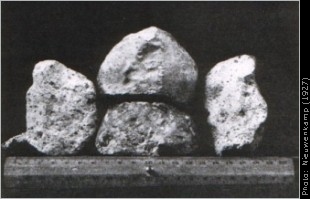 Ellemeet:
fell 28 August 1925, stony meteorite, achondrite of type Diogenite
Ellemeet:
fell 28 August 1925, stony meteorite, achondrite of type Diogenite Ellemeet:
fell 28 August 1925, stony meteorite, achondrite of type Diogenite
Ellemeet:
fell 28 August 1925, stony meteorite, achondrite of type Diogenite
The Ellemeet was a witnessed multiple fall, which occurred on the island of Schouwen (Dutch province of Zeeland, in the southwest of the country) on August 28, 1925 between 11 and 12 am local time. The meteorite fragmented into at least two fragments during its passage through the atmosphere. Witnesses heard high pitched screaming sounds in the sky, frightening cows and horses, followed by the sound of an impacting object. A witness saw a 970 gram weight fragment of the meteorite, measuring approximately 10 centimeters in diameter, impact in a meadow: this fragment generated a half meter deep impact pit. The impact of a second fragment of about 500 grams weight occurred about 1.5-2 kilometers northwest of the first impact: this one struck an impact pit of 40 cm depth. The 970 grams fragment, partly fusion crust covered, is the only truly recovered and preserved fragment, although it fell apart into multiple pieces after recovery. The other stone was left in the field and reportedly crumbled to dust within a year. There is one eyewitness account of the fireball accompanying the fall: the witness report includes the visibility of a dark dust cloud.
The Ellemeet is a stony meteorite of the rare Achondrite class. It is an Orthopyroxenite which belongs to the HED-group and is classified as a Diogenite, the most rare member of this group and a meteorite type of which only some 10 falls are known worldwide. The Ellemeet has the highest Fe,Ni content of all known Diogenites (0.8 vol %) and a high Troilite (FeS) content of 3.3 vol %. It includes a dark carbonaceous chondritic clast with affinities to CR type carbonaceous chondrites (see Zolensky et al., 1996). Such clasts are known from polymict Eucrites and Howardites, but the Ellemeet so far is the only Diogenite known to contain one. Strictly speaking, it is therefore a polymict breccia, once part of an impact excavated and impact mixed surface layer on the parent asteroid (Orthopyroxenes themselves are originally formed at depth in the parent body, they are plutonic rocks). The clast originates from the impact of a CR-like carbonaceous meteorite on the parent asteroid of the Ellemeet. The cosmic exposure age of the Ellemeet Diogenite has been determined as 23.7 ± 1.0 million years by Welten et al. Thus, some 24 million years ago an impact freed the Ellemeet from its parent body. It is currently believed that HED-group meteorites (Howardites, Eucrites and Diogenites) such as the Ellemeet are fragments of the asteroid 4 Vesta: so on 28 August 1925 a piece of Vesta might have hit the Netherlands!
Samples (Grady, 2000): 918 g, Univ. Utrecht; 18 g, Univ. New Mexico, Albuquerque; 15 g, British Museum Natural History, London; 12.6 g, Museum für Naturkunde, Berlin; 5.8 g, US National Museum, Washington; 2.5 g, Am. Mus. Natural Hist., New York.
primary source: W. Nieuwenkamp, Proceedings Kon. Ned. Akad. Wet. XXX (1927), 724-726.

The Dutch Ellemeet meteorite, being a Diogenite member of the HED class, is believed to originate from asteroid 4 Vesta, photographed here by the author of this website on April 19 and May 3, 1992 from Voorschoten (the Netherlands) with a f1.8/50 mm lens and guided piggyback camera